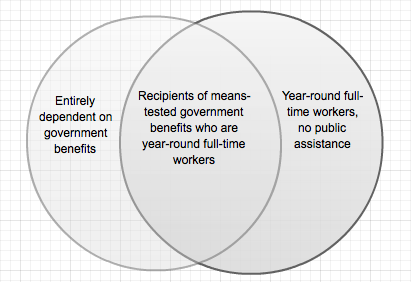@TBPInvictus here.
An IBD editorial picks up on a story originally run over at CNS News. Here’s the lede at CNS (emphasis mine):
(CNSNews.com) – Americans who were recipients of means-tested government benefits in 2011 outnumbered year-round full-time workers, according to data released this month by the Census Bureau. They also out-numbered the total population of the Philippines.
There were 108,592,000 people in the United States in the fourth quarter of 2011 who were recipients of one or more means-tested government benefit programs, the Census Bureau said in data released this week. Meanwhile, according to the Census Bureau, there were 101,716,000 people who worked full-time year round in 2011. That included both private-sector and government workers.
That means there were about 1.07 people getting some form of means-tested government benefit for every 1 person working full-time year round.
Putting aside whatever relevance the population of the Philippines might have, the point being driven home here is clear – the takers outnumber the makers. We’ve become a society of good-for-nothing moochers who have turned the social safety net into a hammock and all want to live off government largesse (notwithstanding occasional GOP claims about Americans being the hardest working people on the planet).
CNS and IBD would have their audiences believe that the two groups – “year-round full-time workers” (makers) and “recipients of means-tested government benefits” (takers) – are separate and distinct.
The CNS/IBD conservative world view looks like this, where the two groups are mutually exclusive:
In fact, nothing could be further from the truth, as was reported earlier this year by the Center on Budget and Policy Priorities (this piece focused on the Supplemental Nutrition Assistance Program – SNAP):
The overwhelming majority of SNAP recipients who can work do so. Among SNAP households with at least one working-age, non-disabled adult, more than half work while receiving SNAP — and more than 80 percent work in the year prior to or the year after receiving SNAP. The rates are even higher for families with children — more than 60 percent work while receiving SNAP, and almost 90 percent work in the prior or subsequent year.
The number of SNAP households that have earnings while participating in SNAP has been rising for more than a decade, and has more than tripled — from about 2 million in 2000 to about 6.4 million in 2011. The increase was especially pronounced during the recent deep recession, suggesting that many people have turned to SNAP because of under-employment — for example, when one wage-earner in a two-parent family lost a job, when a worker’s hours were cut, or when a worker turned to a lower-paying job after being laid off.
And there’s this from the UC Berkeley Labor Center:
Nearly three-quarters (73%) of enrollments in America’s major public benefits programs are from working families. But many of them work in jobs that pay wages so low that their paychecks do
not generate enough income to provide for life’s basic necessities.
Finally, as was widely reported just recently, a McDonald’s internal human resources line suggested an employee explore applying for the very benefits the GOP is apoplectic about dismantling. This from the LA Times:
Nancy Salgado has worked at McDonald’s for 10 years and struggles to support her children with a wage that keeps her under the poverty line.
So she called the fast-food behemoth’s employee hotline, known as McResources, in hopes of finding help making ends meet.
But instead of getting any company assistance, the McDonald’s operator suggested Salgado try food pantries, federal food stamps and Medicaid.
The conversation – which was recorded and released to the public Wednesday by labor advocacy group Low Pay Is Not Ok – comes as attention is growing around the taxpayer burden of so many low-paid workers in the fast-food industry.
In the reality-based world, where the two groups are not mutually exclusive, things actually look like this:
[NOTE: This is a simple rendering, not to any scale, not based on any specific data.]
So, there are two points to be made here:
- There is huge overlap between “year-round full-time workers” and “recipients of means-tested government benefits,” and even organizations as blinded by ideology as CNS and IBD should recognize as much.
- The American taxpayer – through the various safety net programs mentioned – effectively supplements the unlivable wages provided by companies like McDonald’s which is, I suppose, “increasing shareholder value” by outsourcing part of its employees’ incomes to SNAP and other taxpayer-funded programs. If such companies paid their employees a livable wage, said employees would, I’m sure, be delighted at the prospect of not being on public assistance. Hence, if the GOP wants to slash the social safety net, it must consider agreeing to a raise in the minimum wage. You can’t have it both ways – advocating for no minimum wage and then bemoaning the number of people seeking assistance.
And, for the record, I reject the notion that we’ve become a “nation of whiners” suffering through a “mental recession.”
Shame on IBD and Terrence Jeffrey.
Update (November 2): Fox News decided to run with – and further distort – Mr. Jeffrey’s fictional story. Their rendition of it was immediately debunked by Media Matters.
Also, a right-wing talk radio host offered up this particular bit of pablum to his listeners and PolitiFact debunked the story as well.






What's been said:
Discussions found on the web: